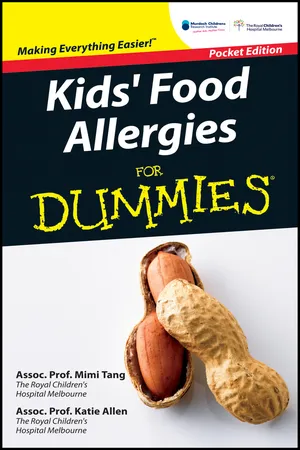Chapter 1
Finding Out How Food Can Make Kids Sick
In This Chapter





Food allergies are much more common now than they used to be. People often say to us ‘You know, when I was growing up, I didn’t know anybody who had a food allergy. Nowadays, it seems like everyone has one, or more!’ And it’s true. Just about everyone we meet knows someone with food allergies and almost every school or childcare centre has at least one enrolled child with food allergy.
In this chapter, we give you an overview of food allergies in Australia and New Zealand, and define some allergy jargon. We also cover management of food allergies.
Describing Food Allergies in Kids
The term food allergy is bandied about quite a lot, and is often used incorrectly to describe any bad reaction to a food. A lot of confusion also surrounds what a food allergy is and what food intolerance is; many people use these labels interchangeably, but these are very different conditions. Because of this confusion, almost ten years ago the World Allergy Organization brought together a team of experts from around the globe to develop consensus definitions describing the different reactions to foods.
These experts decided that any reaction to a food that’s reproducible would be called a food hypersensitivity, and that these food hypersensitivities could be divided into either food allergies or food intolerances depending on what was causing the reaction.
Reacting badly to food
The body can react badly to a food for many different reasons. For example, a reaction may occur because of chemicals in the food itself, because the body can’t break down the food properly or because the person’s immune system has recognised the food as harmful and so reacts to the food.
When the immune system incorrectly interprets food as harmful, you get a food allergy. Now, each time people with egg or peanut allergy eat egg or peanut, their immune system reacts to the food and causes an allergic reaction.
Defining the difference between food allergies and intolerances
The term food intolerance is used to describe all reproducible reactions to foods that aren’t food allergies. While food allergies are caused by the immune system recognising the food as harmful (refer to the preceding section), food intolerances are caused by substances within the food itself that can cause a bad reaction (such as scromboid food poisoning, from eating bad fish, or the compounds in tomatoes and strawberries that release histamines, or problems in the body that make it difficult to digest the food (such as lactose intolerance, when a person lacks the enzyme lactase that breaks down lactose in foods).
Distinguishing between food allergies and other forms of adverse reactions to food is important, because food allergies, and more particularly IgE mediated food allergies (also known as immediate food allergies), are the only types of reaction that are associated with anaphylaxis (a severe allergic reaction affecting the breathing or circulation) — which can be life-threatening.
Pointing the finger at common allergies in kids
The most common allergies in children are to egg, milk and peanut, followed by soy, wheat and tree nuts. Children can also develop allergies to fish and shellfish, although these more commonly develop in adults. These eight food groups cause more than 90 per cent of all food allergies (see Chapter 2 for more details on foods that cause allergy). Doctors don’t fully understand why these particular foods are more likely to cause allergy while all the other foods in the diet don’t; many researchers are investigating this.
Busting myths about anaphylaxis
Anaphylaxis is a severe allergic reaction that’s life-threatening. This reaction is the most severe form of an immediate, or IgE mediated, food allergy reaction, and can only occur in children with IgE mediated food allergy.
The term anaphylaxis is used when an IgE mediated food allergy reaction affects the airways (breathing) or the circulation. If the breathing system is affected, you can have difficulty breathing, a hoarse voice, persistent coughing, or noisy breathing (wheezing or stridor). If the circulation is affected, children (especially babies) become pale and floppy or they may even collapse (although this is rare). The situation is very serious if the circulation becomes involved, because this is considered to be the most severe type of anaphylaxis. (Chapter 6 discusses anaphylaxis in more detail.)
While food allergies are common in children, affecting up to 10 per cent of children in Western countries, most food allergy reactions aren’t life-threatening and are mild to moderate in severity, causing hives, swelling, vomiting, tummy pain or diarrhoea. Severe reactions (anaphylaxis) are less common, and only about 1 per cent of children with food allergy will have anaphylaxis.
The important thing is to know how to recognise a severe reaction so that you can act quickly and confidently to initiate the correct care as quickly as possible.
Understanding Why Some Kids Have Allergies and Others Don’t
Parents are often dismayed that one of their children has a food allergy while their other children, raised in the same environment, don’t. This tells us that genes aren’t the only factor that determine whether or not a child gets a food allergy, and also that the environmental factors that influence the risk of developing allergic disease are complex. While all children may seem to have been provided with exactly the same environment while they were growing up, the environments for each child were likely to be different in many ways.
Also, we know that the genes interact with the environment and this interaction is what ultimately regulates the immune system towards a healthy state of tolerance or towards the development of allergy.


